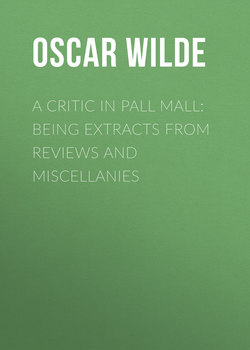A Critic in Pall Mall: Being Extracts from Reviews and Miscellanies

Реклама. ООО «ЛитРес», ИНН: 7719571260.
Оглавление
Wilde Oscar. A Critic in Pall Mall: Being Extracts from Reviews and Miscellanies
THE TOMB OF KEATS
KEATS’S SONNET ON BLUE
DINNERS AND DISHES
SHAKESPEARE ON SCENERY
HENRY THE FOURTH AT OXFORD
A HANDBOOK TO MARRIAGE
TO READ OR NOT TO READ
THE LETTERS OF A GREAT WOMAN
BÉRANGER IN ENGLAND
THE POETRY OF THE PEOPLE
THE CENCI
BALZAC IN ENGLISH
BEN JONSON
MR. SYMONDS’ HISTORY OF THE RENAISSANCE
MR. MORRIS’S ODYSSEY
RUSSIAN NOVELISTS
MR. PATER’S IMAGINARY PORTRAITS
A GERMAN PRINCESS
A VILLAGE TRAGEDY
MR. MORRIS’S COMPLETION OF THE ODYSSEY
MRS. SOMERVILLE
ARISTOTLE AT AFTERNOON TEA
EARLY CHRISTIAN ART IN IRELAND
MADAME RISTORI
ENGLISH POETESSES
VENUS OR VICTORY
M. CARO ON GEORGE SAND
A FASCINATING BOOK
HENLEY’S POEMS
SOME LITERARY LADIES
POETRY AND PRISON
THE GOSPEL ACCORDING TO WALT WHITMAN
IRISH FAIRY TALES
MR. W. B. YEATS
MR. YEATS’S WANDERINGS OF OISIN
MR. WILLIAM MORRIS’S LAST BOOK
SOME LITERARY NOTES
MR. SWINBURNE’S POEMS AND BALLADS (third series)
A CHINESE SAGE
MR. PATER’S APPRECIATIONS
SENTENTIAE
Отрывок из книги
During my tour in America I happened one evening to find myself in Louisville, Kentucky. The subject I had selected to speak on was the Mission of Art in the Nineteenth Century, and in the course of my lecture I had occasion to quote Keats’s Sonnet on Blue as an example of the poet’s delicate sense of colour-harmonies. When my lecture was concluded there came round to see me a lady of middle age, with a sweet gentle manner and a most musical voice. She introduced herself to me as Mrs. Speed, the daughter of George Keats, and invited me to come and examine the Keats manuscripts in her possession. I spent most of the next day with her, reading the letters of Keats to her father, some of which were at that time unpublished, poring over torn yellow leaves and faded scraps of paper, and wondering at the little Dante in which Keats had written those marvellous notes on Milton. Some months afterwards, when I was in California, I received a letter from Mrs. Speed asking my acceptance of the original manuscript of the sonnet which I had quoted in my lecture. This manuscript I have had reproduced here, as it seems to me to possess much psychological interest. It shows us the conditions that preceded the perfected form, the gradual growth, not of the conception but of the expression, and the workings of that spirit of selection which is the secret of style. In the case of poetry, as in the case of the other arts, what may appear to be simply technicalities of method are in their essence spiritual not mechanical, and although, in all lovely work, what concerns us is the ultimate form, not the conditions that necessitate that form, yet the preference that precedes perfection, the evolution of the beauty, and the mere making of the music, have, if not their artistic value, at least their value to the artist.
It will be remembered that this sonnet was first published in 1848 by Lord Houghton in his Life, Letters, and Literary Remains of John Keats. Lord Houghton does not definitely state where he found it, but it was probably among the Keats manuscripts belonging to Mr. Charles Brown. It is evidently taken from a version later than that in my possession, as it accepts all the corrections, and makes three variations. As in my manuscript the first line is torn away, I give the sonnet here as it appears in Lord Houghton’s edition.
.....
and the transcript may have been carelessly made, but having got his line right in his first draft, Keats probably did not spoil it in his second. The Athenæum version inserts a comma after art in the last line, which seems to me a decided improvement, and eminently characteristic of Keats’s method. I am glad to see that Mr. Buxton Forman has adopted it.
As for the corrections that Lord Houghton’s version shows Keats to have made in the eighth and ninth lines of this sonnet, it is evident that they sprang from Keats’s reluctance to repeat the same word in consecutive lines, except in cases where a word’s music or meaning was to be emphasized. The substitution of ‘its’ for ‘his’ in the sixth line is more difficult of explanation. It was due probably to a desire on Keats’s part not to mar by any echo the fine personification of Hesperus.
.....